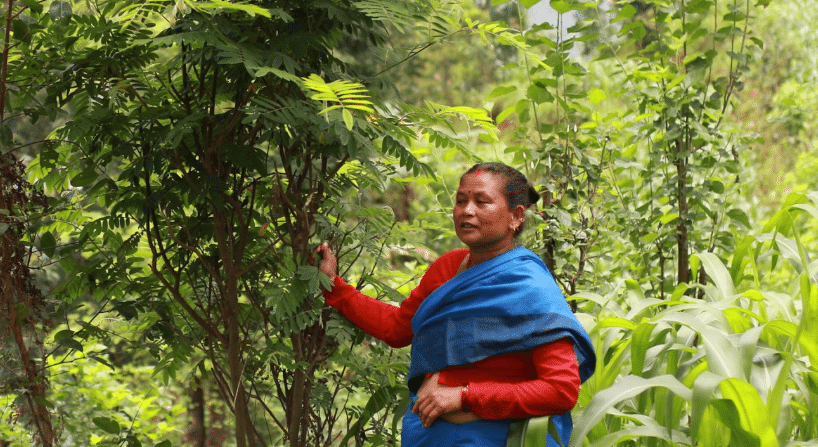Hiding in Plain Sight: Why Savings and Credit are Still Essential to Crushing Poverty.
May 26, 2022
Return to Agroforestry Empowers Women in Nepal
July 8, 2022Bamboo Is a Salve for Impoverished Nepal

By Peter Coy
Bamboo makes a fascinating case study of how to do developmental assistance right.
Take Nepal, where the fast-growing plant (technically a grass, not a tree) has hundreds of traditional uses — as food, spears, flutes and construction materials for houses, goat pens, wedding stages and funeral biers.
But the Nepalese haven’t always extracted the maximum economic value from the bamboo that grows all around them. International charities are helping to change that, offering hope for other low-income communities.
More effective cultivation and use of bamboo won’t by itself turn around the fortunes of Nepal, a nation of about 30 million situated on the roof of the world between India and China. Nongovernmental organizations have spent decades and millions of dollars on efforts to lift up Nepal, whose growth has been hampered by geographical isolation, earthquakes, political violence and corruption. Many Nepalese have given up trying to make a living in the country and instead work abroad, sending money home to their families.
Still, every little bit helps. For some families, at least, the cultivation and sale of bamboo provide a source of income that makes life a little better and, in the best case, puts them on a virtuous circle path toward better health, education and prosperity. So I spent some time speaking with people in Nepal about how such a simple and ubiquitous crop can change fortunes there.
Srijana Karki, the South Asia regional director for the U.S.-based charity World Neighbors, who is based in the Nepali capital of Kathmandu, told me in a video call that resistance to cultivating bamboo remains, and pointed to one village’s superstitions. “They would hire someone from outside the community — the bamboo grandfather — to plant bamboo because they were afraid if they did it themselves there would be a bad omen in the house or someone would die,” she said.
“Field staff explained it hasn’t happened in any other communities. One or two brave people mustered up the courage and they did the bamboo planting. Nothing happened to them. In fact, it gave an added income stream,” said Karki. Since then, she said, many others have planted bamboo, despite their initial reservations.
One key advantage of bamboo is that it costs virtually nothing to grow, so even a small revenue stream is pure profit.
Bamboo also prevents erosion when it’s planted on patches of what was bare soil. It filters pollutants out of water. Bamboo shoots are a mainstay of Nepali cuisine, as they are in other Asian nations. Bamboo stems, known as culms, make sturdy beams, trusses, scaffolding and fences. Bamboo is also used to make furniture and decorative baskets, trays and other products sold to tourists, whose spending is crucial to Nepal’s economy.
With Karki interpreting, I spoke by video with Kamal Shrestha, a former ward chief of one of the communities in the Udayapur District of Nepal’s Province No. 1. There was, he said, a lot of wasted land in Udayapur. More of those empty areas are now being used productively, he said.
I also spoke with Shankar Thapa, the chair of the Human Rights and Environment Development Center in Udayapur, which is World Neighbors’ partner organization in the district. (By law, all international nongovernmental organizations must work through Nepali ones.) He said he likes World Neighbors’ emphasis on teaching skills rather than simply giving money. “Beneficiaries become very active because they are doing the main work,” he said. “If they want to progress they have to do it.”
Though bamboo covers much of Nepal, the Nepalese don’t know everything about it. As in the United States, where agriculture extension arms of universities help farmers, so it is that villagers can learn some useful tricks from experts within and sometimes outside Nepal.
The Bamboo’s Secret, a U.S.-based charity, has a school in the Chapakot municipality of central Nepal that teaches widowed and divorced women salable crafts that use bamboo. It has its own bamboo nursery on the premises.
Habitat for Humanity is teaching Nepalese women to build bamboo houses, a job that was once reserved for men, and make bamboo handicrafts. “Before, we didn’t weave these trays. We didn’t even have the knowledge to weave bamboo,” a woman named Maya Sunuwar says in a Habitat for Humanity Great Britain video.
There are as many as 1,600 species of bamboo, some more commercially useful than others. For example, Arundinaria bamboo is rare, grows in soil above 2,900 meters, is browsed by yak and other wild animals and is made into arrows, brushes and straws, according to a detailed table made by Keshab Shrestha, a former professor at Tribhuvan University in Kathmandu.
And as any agriculture extension agent would tell you, there is a right and a wrong way to do everything on a farm. “The bamboo needs to be harvested in the dry season, preferably at new moon (first quarter), and the leaves left on for a few days (until they turn yellow) to allow them to extract the moisture from the stems,” says a set of instructions made by Sjoerd Nienhuys, an architectural engineer based in the Netherlands.
There’s a lot more to Nepal than bamboo, of course, and many national and international nongovernmental organizations are working on other pressing matters, from other kinds of agriculture to reproductive health and education. But for many Nepalese, turning bamboo into money can be a step toward financial independence.
This article originally appeared on nytimes.com on June 6, 2022.

